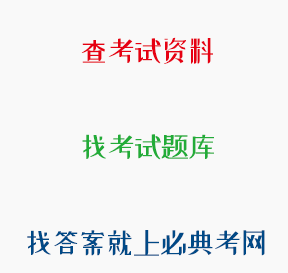正确答案:
题目:阅读下面的材料,根据要求作文。
一个小女孩的玩具车刮到了一位老人,老人坐在地上与孩子家长理论。有人录下现场视频即传至网上,不少人认为是碰瓷。老人被送医检查后,确诊桡骨骨折。事实是,老人并非碰瓷,还婉拒了女孩家人更多的赔偿和照顾。
综合上述材料所引发的思考和感悟,写一篇不少于800字的论说文。
要求:
用规范的现代汉语写作,角度自选,立意自定,标题自拟。
解析:【解析】(一)评分标准:
一等(50-38)紧密围绕教育背景、教师身份写作,立意切合"教师的职业光辉伟大""教师的工作职责"等题意,中心突出,内容充实、情真意切、结构严谨、文体明确、语言优美、引经据典、字体优美;(教育学、心理学、教师职业素养,结合教育场景、学生心理,站在教育事业发展、教育体制改革的维度书写)
二等(37-25)站在教师立场思考主题,中心符合"教师应具备哪些知识技能""教师应具备那些专业素质"等角度,中心明确,内容较充实、感情真实、结构完整、文体突出、语言通顺、字迹清楚:(符合教师的职业素养,稍微联系理论和现实)
三等(24-12)中心基本符合题意、基本明确,内容单薄、感情基本真实、结构基本完整、文体基本符合、语言基本通顺、字迹潦草:
四等(11-0)"三观"观念错误,中心偏离题意、不明或立意不当、内容空洞、文体不明、矫揉造作、结构混乱、语病多、字迹难辨。(不具备作为教师的基本素质和辨别是非的能力,基本写作能力欠缺)
(二)写作硬性扣分项目:写作与文章相关的硬伤主要集中在内容残缺和语言表达基本功上,主要几大硬性扣分项目有:标题:不写,扣5分;文章结尾:不写,字数多于600字,扣10分;少于600字,残文11分以下;语句错误:2个扣1分,5个扣3分,多余5个,字句错误降等,降12分。
查看原题 查看所有试题
学习资料的答案和解析:
[单选题]体育是以( )为目标的教育活动。
发展体能,锻炼体魄
解析:体育是授予学生体育卫生知识和技能,使学生增强体质,发展机体素质和运动能力,养成良好的卫生、保健习惯的教育。体育为人的全面发展教育提供了重要物质基础。故选择C。A项,智育的主要任务包括向学生传授系统的文化科学基础知识、培养训练学生形成基本技能和技巧、发展学生智力。B项,德育的主要任务是培养学生良好的道德品质、培养学生具有道德评价和自我教育的能力、培养学生正确的世界观。D项,美育的主要任务包括培养学生正确的审美观点,使他们具有感受美、理解美和鉴赏美的知识和能力;培养学生艺术活动的技能,发展艺术创造能力:培养学生美好的情操和文明行为习惯。
[单选题]有人记忆马克思的生日1818年5月5日时,联想为"马克思一巴掌一巴掌打得资产阶级呜呜地哭",这是使用了( )。
精细加工策略
解析:题干所述例子为谐音联想法。精细加工策略是一种理解性的记忆策略,利用谐音联想法帮助记忆是其中一种。故选择B。A选项,组织策略是指整合所学新知识之间、新旧知识之间的内在联系,形成新的知识结构的策略。C选项,元认知策略是学生对自己认知过程的认知策略,即对信息加工过程进行调控的策略,包括对自己认知过程的了解和控制策略,有助于学生有效地安排和调节学习过程。D选项,复述策略是在工作记忆中为了保持信息,运用内部语言在大脑中重现学习材料或刺激,以便将注意力维持在学习材料上的策略。
[单选题]( )在德育过程中起主导作用。
教育者
解析:教育者是德育过程的组织者、领导者,是一定社会德育要求和思想道德的体现者,在德育过程中起主导作用。教育者包括直接和间接的个体教育者和群体教育者。故选择A。
[单选题]请阅读 Passage 2,完成 1~5小题。
Passage 2
Come on-Everybody's doing it.That whispered message,half invitation and half forcing, is what most of us think of when we hear the words peer pressure.It usually leads to no good-drinking,drugs and casual sex.But in her new book Join the CluB.Tina Rosenberg contends that peer pressure can also be a positive force through what she calls the social cure,in which organizations and officials use the power of group dynamics to help individuals improve their lives and possibly the word.
Rosenberg,the recipient of a Pulitzer Prize,offers a host of examples of the social cure in action: In South Carolina.a state-sponsored antismoking program called rage Against the Haze sets out to make cigarettes uncool.In South AfricA.an HIV-prevention initiative known as loveLife recruits young people to promote safe sex among their peers.
The idea seems promising,and Rosenberg is a perceptive observer.Her critique of the lameness of many pubic-health campaigns is spot-on: they fail to mobilize peer pressure for healthy habits,and they demonstrate a seriously flawed understanding ofpsychology."Dare to be different,please don't smoke! " pleads one billboard campaign aimed at reducing smoking among teenagers-teenagers,who desire nothing more than fitting in.Rosenberg argues convincingly that public-health advocates ought to take a page from advertisers,so skilled at applying peer pressure.
But on the general effectiveness of the social cure,Rosenberg is less persuasive.Join the Club is filled with too much irrelevant detail and not enough exploration of the social and biological factors that make peer pressure so powerful.The most glaring flaw of the social cure as it's presented here is that it doesn't work very well for very long.rage Against the Haze failed once state funding was cut.Evidence that the loveLife program produces lasting changes is limited and mixed.
There's no doubt that our peer groups exert enormous influence on our behavior.An emerging body of research shows that positive health habits-as well as negative ones-spread through networks of friends via social communication.This is a subtle form of peer pressure: we unconsciously imitate the behavior we see every day.
Far less certain,however,is how successfully experts and bureaucrats can select our peer groups and steer their activities in virtuous directions.It's like the teacher who breaks up the troublemakers in the back row by pairing them with better-behaved classmates.The tactic never really works.And that's the problem with a social cure engineered from the outside: in the real world.as in school,we insist on choosing our own friends.
The author suggests in the last paragraph that the effect ofpeer pressure is________.
questionable
解析:态度题。文章最后一段第一句话指出,专家和政府官员能在多大程度上选择我们的同侪群体并能引导其行为走上正确的道德方向是难以确定的(far less certain),接下来以教师让捣蛋鬼们换座和好学生坐在一起为例子说明“这个策略从来没有真正起作用”。从这里我们可以看出,作者对于同侪压力是否能产生效果其实是持怀疑态度的,故本题选D项“可疑的”。A项“有害的”,B项“有利的”,C项“深刻的”均不正确。

 川公网安备 51012202001360号
川公网安备 51012202001360号